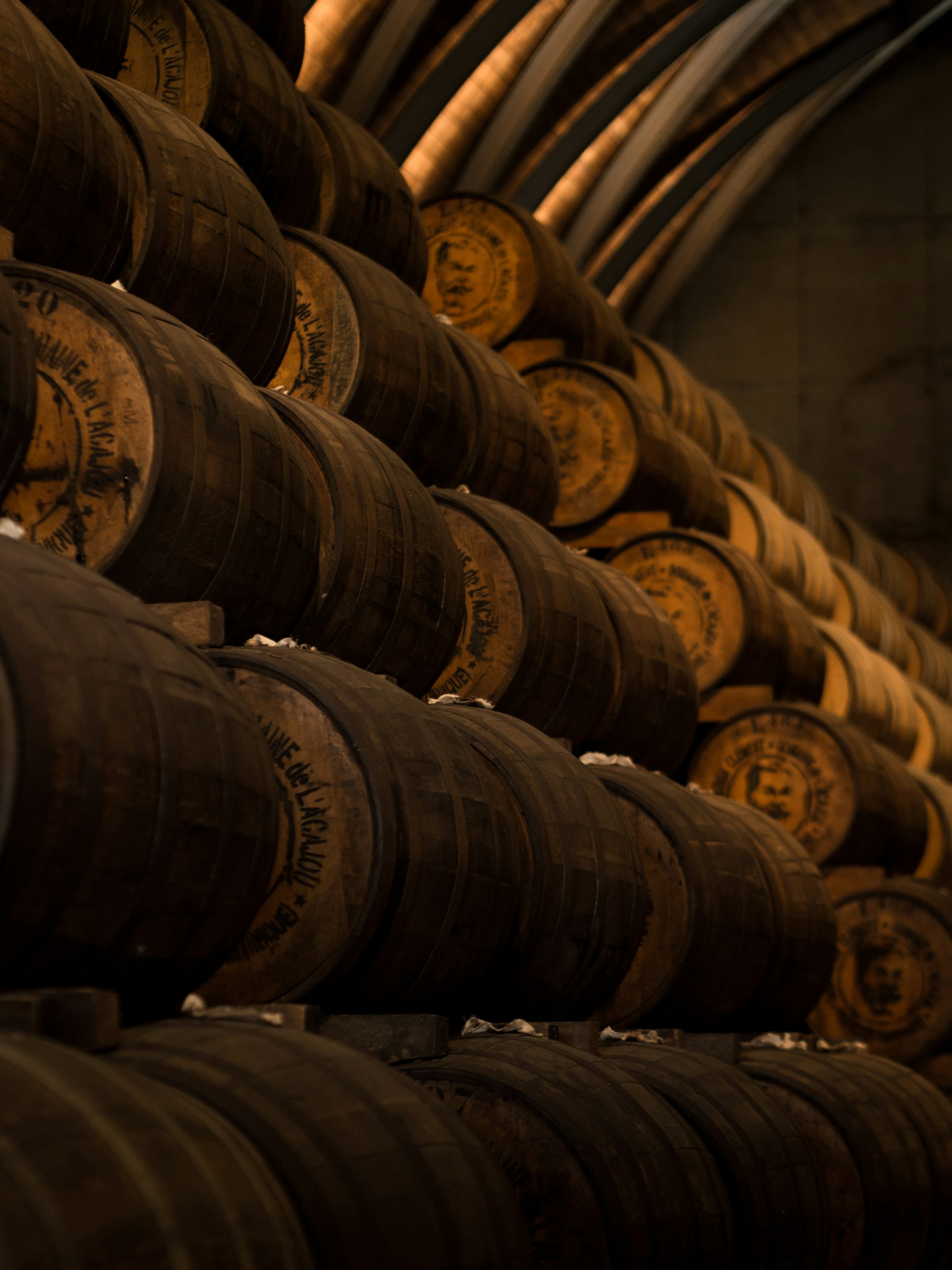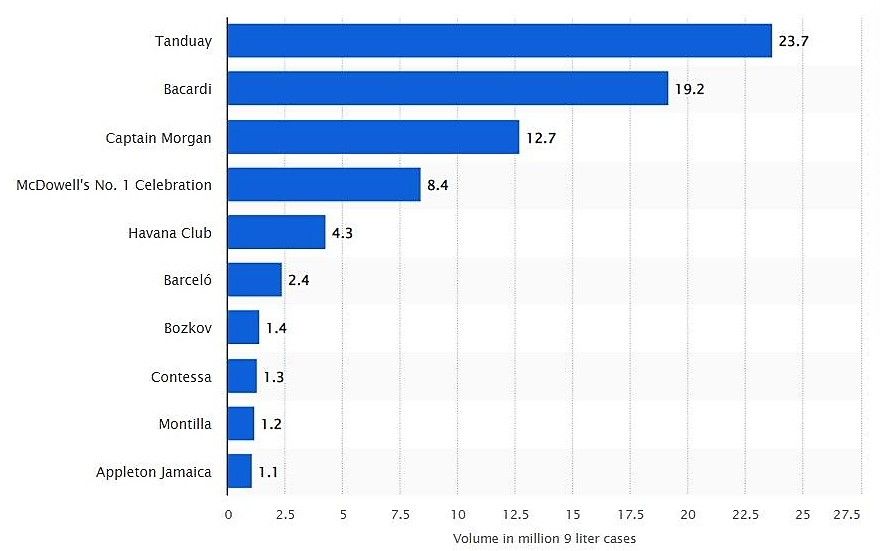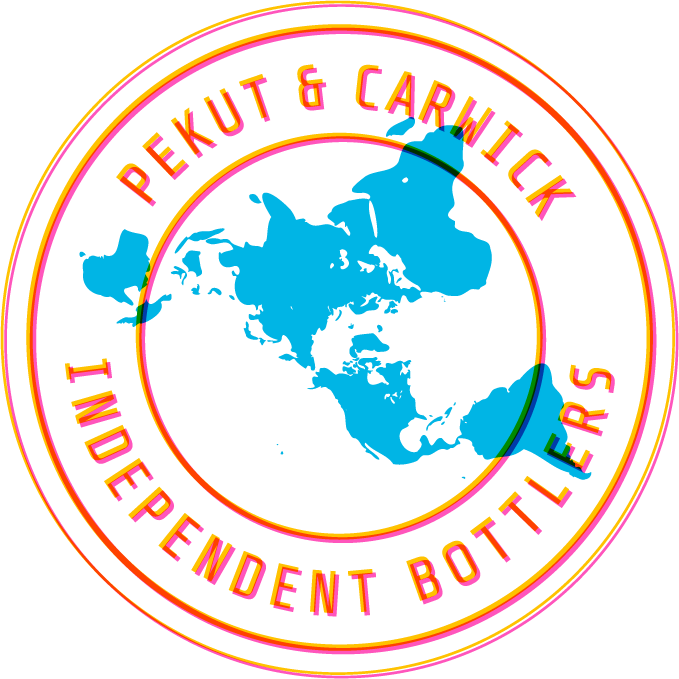The top ten best selling rum brands and what we can learn from them


What's the most sold rum in the world?
The answer might surprise you.
According to one online market research database, the Asia-Pacific rum market accounted for a dominating 41.6% of rum’s market share in 2021, mostly driven by India and the Philippines. When you consider further that Tanduay, in the Philippines, is one of the largest rum brands in the world, that McDowell’s Celebration and Bacardi are neck-and-neck in competition for the Indian market, and that Bacardi has distilleries in India and Mexico, the global rum market starts looking remarkably un-Caribbean. Which makes sense, because...
Most of the world's top ten rum brands aren't in the Caribbean
Take this all with a grain of salt. There are as many ideas of what can be called rum as there are countries (see Bozcov spirits made from sugar beets and therefore excluded here) and a company's relationship to the Caribbean economy isn't necessarily predicted by where governance is located.
We're talking broad strokes, here.
But rum was born of extractive colonial economic practices, including labor cost optimization (slavery) and active relocation of governance and value-added supply chain operations to colonial centers outside the Caribbean (see continental aging, Scottish rum distilleries, colonial American "guinea rum", etc.).
Rum was born a colonial commodity. That's why it's notable to see vertical integration in a modern rum company, where ownership, production, and post-distillation operations (like maturation, blending, and bottling) occur in the same place that the cane is grown.
Observing the market from the lens of a U.S. consumer, you might be forgiven for thinking that the Caribbean should dominate the top ten brands list, given how rum marketing and internet jabber leans so heavily on euro/American-centric Caribbean fantasy (maybe the oft-uttered slur should go "there are no rules in rum... marketing"). After all, it can be difficult to assess what's actually happening in rum markets when you have to wade through decades (centuries, really) of marketing imagery internalized and enshrined into popular perception.
So, because we're obsessed with what's actually in the bottle and how it got there, we scraped up some specs on the biggest rum companies, with particular spin on where these supply streams touch down.
The takeaway? First, global rum brands aren't as Caribbean as our marketing imagery might suggest. Second, remarkably few of the top ten sellers are vertically integrated inside a single national economy, and none of those entirely within a Caribbean economy.
Here's what we know about the biggest global contenders for the rum market:
Bacardi (Bermuda)
Company: Still owned and run by the Bacardi family, but famously not in Cuba anymore. Founded in 1862, Bacardi is now headquartered in Hamilton, Bermuda, with U.S. H.Q. in Coral Gables, FL.
Raw materials: Molasses is sourced from around the world.
Production: Two distillates are produced (one more rectified than the other) on two very large column stills. Filtration is employed to remove unwanted flavor and color from some distillates. Production for most of Bacardi's rum happens at the "Cathedral of Rum" outside San Juan, Puerto Rico, and they have additional facilities in Mexico and India.
Aging: Bacardi doesn't want a lot of oak extract in their rum, so they wash and rechar their used bourbon barrels, and then they only age for 1-2 years before filtration and blending. The barrels are typically reused for aging multiple rums over the next 15 years. Distillates from the San Juan distillery are shipped to Jacksonville, FL for aging.
Barceló (Dominican Republic)
Company: Founded in 1930 by Julián Barceló, production moved to its current location in San Pedro de Macoris in 1946. Currently owned and operated by a Spanish company.
Raw materials: Sugarcane juice (hyper-local by default, you can't transport this stuff very far without it going bad).
Production: A very neutral 95% spirit is distilled on a large continuous column still at their facility in San Pedro de Macoris. Not a funky cane juice distillate.
Aging: Proofed distillate is matured on-site in a combination of new and old ex-bourbon, with the oldest barrels over 50 years (!) old. Some French oak is used.
Tanduay (Philippines)
Company: Early iterations date back to the 19th century, but by the early 1930s the Manila-based distillery was operating under its current brand name, Tanduay. The distillery has changed hands many times and is now owned by Filipino business magnate Lucio Tan.
Raw materials: Grade A molasses extracted from sugar cane grown on the Philippine island peninsula of Negros Occidental.
Production: Column stills are used for both filtered (silver) and unfiltered (gold) varieties at several distilleries in the Philippines.
Aging: Matured in the Philippines using ex-bourbon barrels and both single-barrel and Solera methods.
Captain Morgan (UK)
Company: Founded by British company Seagrams in 1944, when it bought the rights to produce a spiced rum from a Jamaican pharmacy. It is now owned by multinational alcohol conglomerate Diageo based in London.
Raw materials: Molasses from unknown countries of origin, possibly the Virgin Islands and Jamaica, likely many others including Brazil and India.
Production: Contract-distilled in Puerto Rico and other locations until 2010, when Captain Morgan built a distillery and started producing in St. Croix. Spices and flavorings are added at some point in the process, it's not clear when.
Aging: Captain Morgan advertises aging in charred oak barrels but they're evasive about how long it takes. It's safe to assume that they're using ex-bourbon barrels. They also built two 100,000 square foot warehouses, so it's also safe to assume that at least some aging is happening in St Croix.
McDowell’s (India)
Company: Founded in 1826 by Scotsman Angus McDowell, the company originally made Scotch-style whisky in India under the name of McDowell and Company. In the early 90s, they began producing rum, possibly in Goa, with headquarters in Bangalore. Around the same time, it became part of United Spirits Limited, and in 2013, Diageo (multinational, HQ in London) gained majority control.
Raw materials: Possibly made from molasses but we can't confirm that, nor can we confirm raw material sourcing.
Production: Almost certainly produced in column stills at several sites in India.
Aging: Both white and aged expressions are available. Public information about McDowell's is limited, so we can only speculate.
Havana Club (Cuba)
Company: Originally founded in 1934 by Jose Arechebala S.A., this family-owned conglomerate had ties to mid-19th century Cuban rum production. After the Cuban Revolution ended in 1958, Havana Club was nationalized and renamed. Since 1994, government-owned Cubaron has distributed via a joint partnership with Pernod Ricard (a French company). The Arechabala family were exiled from Cuba and eventually sold their original trademark and rum recipe to Bacardi, and a long intellectual property dispute continues to play out.
Raw materials: Made with molasses derived from locally grown sugarcane—by law, Cuban rum has to be made from molasses.
Production: Two distillates are produced on column stills at multiple locations in Cuba.
Aging: Both white and aged rums are available, of various ages. Post-maturation filtration is also used. Cuban rum aging is fascinatingly complex and regulated.
Old Port (India)
Company: Founded in 1948 by Amrut Distilleries Private Limited to produce whiskies. In the 60s, Amrut began making rum.
Raw materials: According to marketing content from several online retailers, Amrut Distilleries only uses molasses derived from Indian sugarcane.
Production: Produced in Bangalore where the Amrut Distilleries headquarters are also located. Interestingly, the web is peppered with references to the company eschewing automation in favor of creating jobs, but Amrut's website doesn't have this information readily available anymore.
Aging: Rums are aged, but we're not sure for how long.
Appleton Estate (Jamaica)
Company: The Appleton Estate Distillery dates back to 1749 when enslaved Africans made up the labor force. In 1910 J. Wray & Nephew purchased Appleton Estate and in 2012 both brands were purchased by Gruppo Campari (Italy).
Raw materials: Made with molasses derived from Appleton Estate's extensive sugarcane farm.
Production: Appleton Estate boasts of their "cane-to-cup" product in an industry traditionally fragmented between sugarcane producers, distillers, distributors, etc. Appleton Estate also employs and celebrates the world's first female master blender, Joy Spence. The rum is produced in a combination of pot and column stills on site.
Aging: Rums are aged in oak barrels on site for anywhere from eight to fifty years.
Negrita (France)
Company: The Bardinet Company has produced Negrita rum since the around 1886, when owner Paul Bardinet copyrighted the name "Negrita." The name of this rum and it's label design are textbook examples of post-colonial exoticism: "Negrita", borrowed from Spanish, being a gendered diminutive reference to the image of a Black woman illustrated on the label (for a well-reasoned rebuke, read Jordan McDonald's essay in The Offing). Blending operations have been based in Bordeaux, France, since 1895, and the company is now owned by French alcohol conglomerate La Martiniquaise. The literal translation for this French title is "the Martinican woman" (whoops, I think your colonial underpants are showing.).
Raw materials: Cane juice and molasses from Martinique, Réunion, and Guadeloupe.
Production: Blended in France, distilled in the islands.
Aging: Some expressions are aged in oak but we're not sure for how long or where.
Contessa (India)
Company: Founded in 1943, Radico Khaitan Limited, then known as Rampur Distillery & Chemical Company, is one of the oldest and largest manufacturers of Indian Made Foreign Liquor (IMFL, an official domestic term for non-indigenous spirits). They also produce fertilizers and PET bottles.
Raw materials: We don't know where the raw materials for Contessa XXX are sourced.
Production: Radico Khaitan has several distilling and bottling operations in India. Rampur distillery is notable for its cogeneration plant which converts effluent (spent wash) into biogas which, according to Radico Khaitan, makes it "almost self reliant".
Aging: According to Radico Khaitan's website, it's "aged in wood".
Montilla (Brazil)
Company: Originally owned by Destilaria Medellin, purchased by Seagrams (Canada) and now owned and distributed in Brazil by Pernod Ricard (France).
Raw materials: Unknown.
Production: Unknown.
Aging: Unknown.
Conclusion #1: NONE of the top rum brands are 100% Caribbean
Havana Club has been most able to retain vertical integration within its own Caribbean economic boundaries, with only part ownership with Italian company Pernod Ricard. Appleton Estate and Barceló are runners up, with controlling interests in Italy and Spain. But there's not a single 100% Caribbean company represented in this top selling brands list.
Conclusion #2: there are only a few vertically integrated top rum brands
Brand vertical integration, where the entire supply chain from raw materials to marketable bottled spirit is located in the same place, is rare among the top rum sellers. As far as we can tell, only three brands on this list appear to have retained all functions within their domestic economies: Tanduay (Philippines), Old Port (India), and Contessa (also India).
Rum is complicated
We've been hearing forever that rum is the next big thing, but for some reason it never quite seems to happen. We'd like to propose a theory: rum won't ever get there until we start calling BS on the story we tell ourselves about it. The ridiculous and incomprehensible conflict between rum's obvious colonial core and the rosy euphemisms by which we sell and buy it are easy to find if you're paying attention. Rum isn't the next big thing because not only is it contentious to sugar-coat history, it's boring, too.
Bourbon doesn't have this problem, neither does Scotch: both exist neatly in their domestic economies and popular perception, with vertical integration at least partially guaranteed by international trade agreements. But rum, whose origins are distributed according to the expansion of colonial sugar production, isn't so easy to protect, or even explain. Our proposal is simple: let's tell the real story.
Sources
Wikipedia: J Wray & Nephew Rum
The Spirits Business: Appleton Estate
Difford's Guide: Casa Bacardi 'The Cathedral of Rum'
Casa Bacardi "The Cathedral of Rum"—Difford's Guide
Barceló: The Quintessential Dominican Rum—Forbes
Vinepair: 11 Things You Didn't Know About Captain Morgan
Caribbean Journal: USVI Governor Accepts First Case of St Croix-Produced Captain Morgan Rum
Captain Morgan: How Rum Is Made
Radico Khaitan: Rampur Distillery
The Cocktail Wonk: Inside Havana Club's Inner Sanctum
Wikipedia: José Arechabala S.A.
Wikipedia: Jose Arechabala S.A.
Wikipedia: United Spirits Limited
The Rum Howler: McDowell's Rum
The Gin Blog: Pernod Ricard Increases Its Stake in Brazil
YouTube: Ron Montilla du Brasil
Montilla Digital: Ron 'Montilla'. Breve historia de un enigma.
The Spirits Business: Negrita, a brand history
The Spirits Business: Negrita: a brand history
The Lone Caner: Amrut Old Port Deluxe Rum Review
The Rum Howler: Amrut Old Port Deluxe Rum
Forbes: After Whisky, Is This The Next Spirit To Watch?
The 10 Largest Rum Brands In The World (zippia)
Tractor Junction: Sugarcane Production in India
Diford's Guide: How Tanduay Rum is Made

